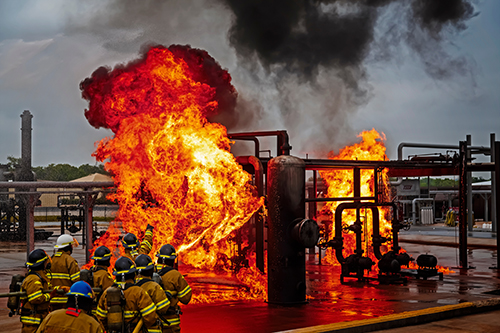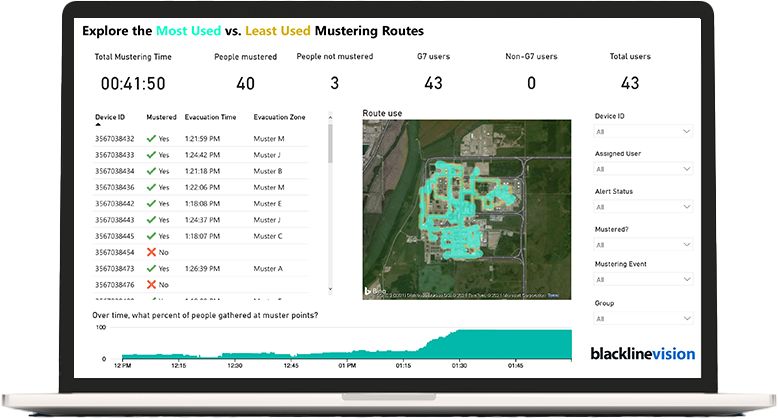In case you missed it you can find Part 1 HERE
The production of oil and gas is inherently dangerous, with risks existing in all three segments of the process. A connected safety solution is vital for organizations in this industry to respond to incidents and to develop preventative measures for the future. Predicting and rapidly responding to safety hazards ensures that every worker gets home safely — after every shift.
Continuous, real-time gas monitoring.
Because connected safety solutions continuously monitor gas levels in real-time, they can identify potentially hazardous levels before an incident occurs, causing damage to facilities, equipment—and potentially harming the workers that operate them.
Continuous monitoring is common in confined space entries (CSEs), such as storage tanks, mud pits, process vessels and trenches, pose elevated risk because hazardous gases can quickly concentrate to dangerous levels or displace oxygen in poorly ventilated spaces.

Using connected safety devices, such as Blackline’s G7 EXO Area Monitor or G7c Multi-gas Pump Detector ensures these areas are safe for workers before they enter and alerts them to evacuate if gas levels exceed safe thresholds. With an extended battery life of 100+ days, the EXO allows for extended CSEs without needing to re-permit.
Continuous monitoring makes it possible to identify gas leaks, preventing potentially devastating incidents. For example, 24/7 area gas monitoring can detect if a piece of equipment is releasing more vapors into an area, indicating a need for repair or replacement. Because they are always connected, the gas readings can be viewed in real-time via the Blackline Live online dashboard.
Continuous monitoring needs to be considered in situations where a worker is in a space where atmospheric conditions have the potential to change (CCOHS).
Streamlining evacuation management.
Flammable gases released from wellbores, storage tanks, production equipment, surface equipment, and other sources across work sites, present significant risk of fire and explosion. Additionally, toxic gases such as hydrogen sulfide can leak and quickly lead to life-threating situations that lead to the need for an evacuation. In the event of an emergency at a facility, connected safety solutions also streamline evacuation procedures.
Continuous monitoring alerts safety personnel to threshold levels of hazardous gases, enabling quick evacuation of workers from affected areas. During an evacuation, team leads can account for the location of every person wearing a connected safety device in real-time to ensure they safely reach muster points. Since worker locations can be seen on the Blackline Live portal, rapid assistance can be sent directly to anyone that doesn’t safely evacuate, rather than conducting manual headcounts and then deploying search parties for anyone unaccounted for. Additionally, because connected devices transmit various types of data, rescue crews can determine the response needed whether it be a fall, no-motion alarm, or elevated gas levels where SCBA equipment may be required.
Fires and explosions are a leading cause of injuries and fatalities in the oil and gas industry (OHS Online).

Predicting safety risks through data analytics.
Unrecognized risks at a worksite can cause worker safety incidents or equipment and facility damage, resulting in unexpected downtime and costs. Connected safety solutions coupled with data science and analytics, such as that offered by Blackline Vision, can identify hazards before they put workers at risk or damage equipment. The ability to detect patterns through connected device readings allows safety managers and operators to take proactive steps to address potential hazards.
For example, fall detection alerts in the same location may indicate a slippery surface from oil and grease, and if reports show it’s only seasonal, it may be due to an icy patch. Proactively cleaning or de-icing the area will mitigate fall risk, keeping operations running smoothly.
Since all readings are collected and streamed to the cloud, data analytics from connected devices can be used to indicate facility areas with potential risk. Gas levels below the threshold for alarms typically go unnoticed until an incident occurs. Reporting on these exposures gives operators the ability to proactively fix leaks or faulty equipment. Preventative maintenance can mitigate a potentially major rescue, evacuation or repair event requiring an unplanned shutdown.
Conclusion
At every stage of oil and gas production—upstream, midstream, and downstream—connected safety solutions are an effective way to proactively prevent safety incidents from occurring to protect both workers and the facility, and to respond quickly to hazardous situations when they do arise.

Learn more:
Watch G7 Videos
Contact Us
Share This:





 CDN NEWS |
CDN NEWS |  US NEWS
US NEWS 































Canada’s Advantage as the World’s Demand for Plastic Continues to Grow